An Overview on Stem Cells, Types, and Medical Applications
VerifiedAdded on 2023/06/10
|5
|1335
|190
Report
AI Summary
This report provides a comprehensive overview of stem cells, discussing their classification into embryonic and adult types, and their differentiation properties. It explains the differences between stem cells and normal cells, and categorizes stem cells into five subtypes based on differentiation potential: unipotent, oligopotent, pluripotent, multipotent, and omnipotent cells. The report details stem cell collection methods from adipose tissue, bone marrow, and umbilical cords, highlighting their applications in medical treatments like bone marrow transplantation and nerve regeneration. It also discusses the use of stem cell therapy for spinal cord injuries, explaining how stem cells boost neuronal regeneration and overcome inhibitory factors. The report concludes by emphasizing the safety and potential of stem cell therapy in diverse fields, including hair and organ transplantation, with ongoing research exploring its application in cancer treatment. The report references several research studies supporting the efficacy of stem cell therapy.
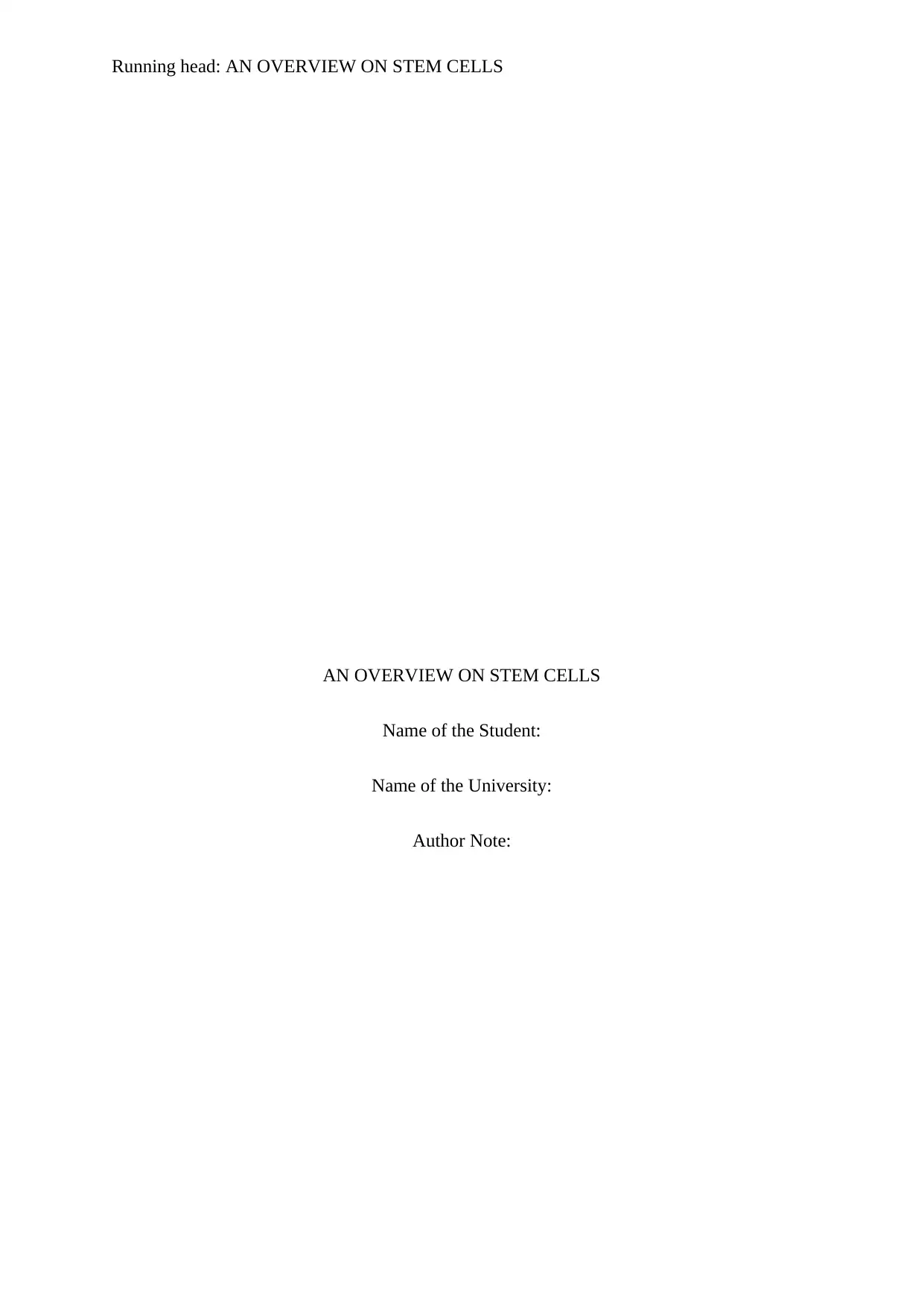
Running head: AN OVERVIEW ON STEM CELLS
AN OVERVIEW ON STEM CELLS
Name of the Student:
Name of the University:
Author Note:
AN OVERVIEW ON STEM CELLS
Name of the Student:
Name of the University:
Author Note:
Paraphrase This Document
Need a fresh take? Get an instant paraphrase of this document with our AI Paraphraser
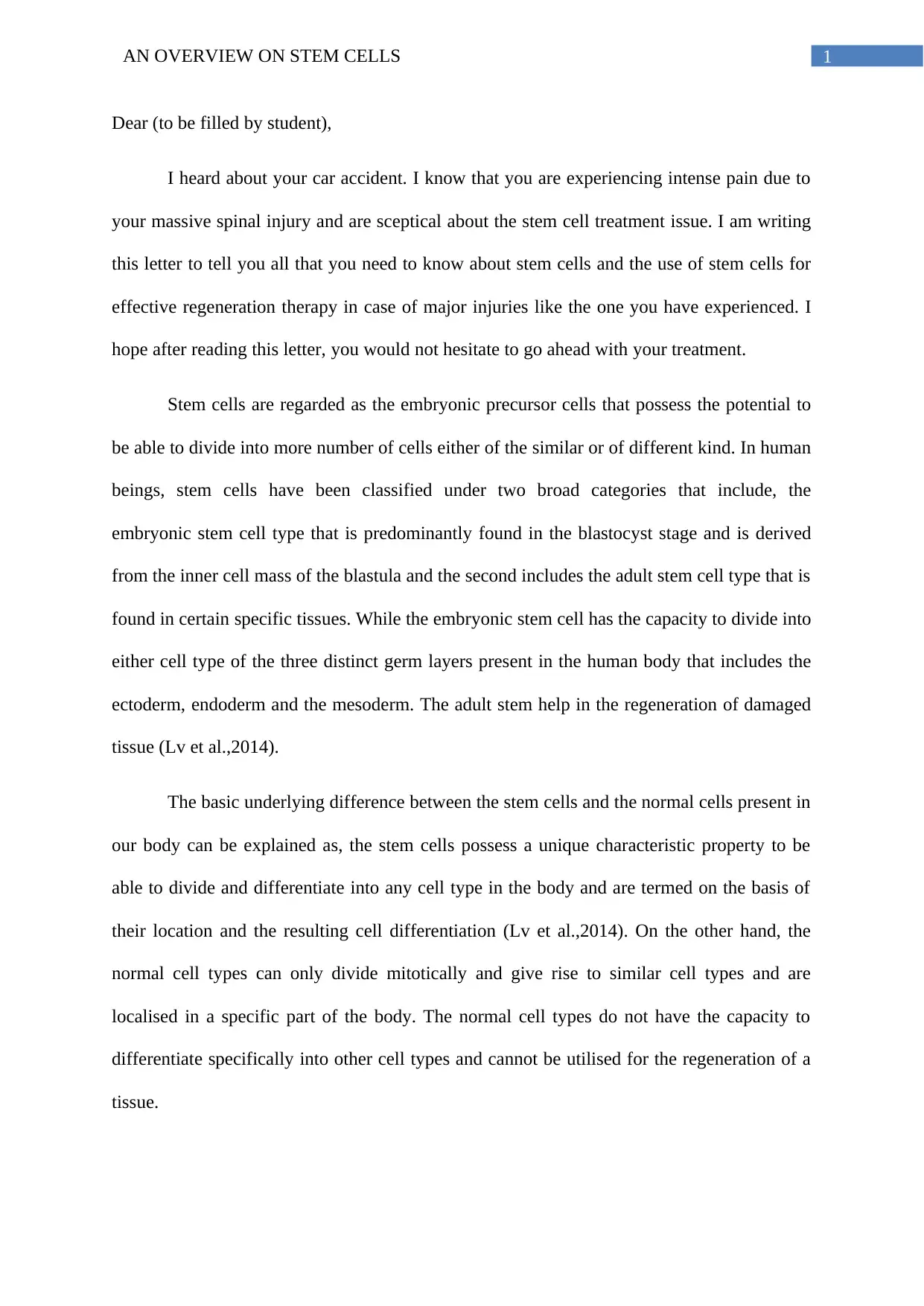
1AN OVERVIEW ON STEM CELLS
Dear (to be filled by student),
I heard about your car accident. I know that you are experiencing intense pain due to
your massive spinal injury and are sceptical about the stem cell treatment issue. I am writing
this letter to tell you all that you need to know about stem cells and the use of stem cells for
effective regeneration therapy in case of major injuries like the one you have experienced. I
hope after reading this letter, you would not hesitate to go ahead with your treatment.
Stem cells are regarded as the embryonic precursor cells that possess the potential to
be able to divide into more number of cells either of the similar or of different kind. In human
beings, stem cells have been classified under two broad categories that include, the
embryonic stem cell type that is predominantly found in the blastocyst stage and is derived
from the inner cell mass of the blastula and the second includes the adult stem cell type that is
found in certain specific tissues. While the embryonic stem cell has the capacity to divide into
either cell type of the three distinct germ layers present in the human body that includes the
ectoderm, endoderm and the mesoderm. The adult stem help in the regeneration of damaged
tissue (Lv et al.,2014).
The basic underlying difference between the stem cells and the normal cells present in
our body can be explained as, the stem cells possess a unique characteristic property to be
able to divide and differentiate into any cell type in the body and are termed on the basis of
their location and the resulting cell differentiation (Lv et al.,2014). On the other hand, the
normal cell types can only divide mitotically and give rise to similar cell types and are
localised in a specific part of the body. The normal cell types do not have the capacity to
differentiate specifically into other cell types and cannot be utilised for the regeneration of a
tissue.
Dear (to be filled by student),
I heard about your car accident. I know that you are experiencing intense pain due to
your massive spinal injury and are sceptical about the stem cell treatment issue. I am writing
this letter to tell you all that you need to know about stem cells and the use of stem cells for
effective regeneration therapy in case of major injuries like the one you have experienced. I
hope after reading this letter, you would not hesitate to go ahead with your treatment.
Stem cells are regarded as the embryonic precursor cells that possess the potential to
be able to divide into more number of cells either of the similar or of different kind. In human
beings, stem cells have been classified under two broad categories that include, the
embryonic stem cell type that is predominantly found in the blastocyst stage and is derived
from the inner cell mass of the blastula and the second includes the adult stem cell type that is
found in certain specific tissues. While the embryonic stem cell has the capacity to divide into
either cell type of the three distinct germ layers present in the human body that includes the
ectoderm, endoderm and the mesoderm. The adult stem help in the regeneration of damaged
tissue (Lv et al.,2014).
The basic underlying difference between the stem cells and the normal cells present in
our body can be explained as, the stem cells possess a unique characteristic property to be
able to divide and differentiate into any cell type in the body and are termed on the basis of
their location and the resulting cell differentiation (Lv et al.,2014). On the other hand, the
normal cell types can only divide mitotically and give rise to similar cell types and are
localised in a specific part of the body. The normal cell types do not have the capacity to
differentiate specifically into other cell types and cannot be utilised for the regeneration of a
tissue.
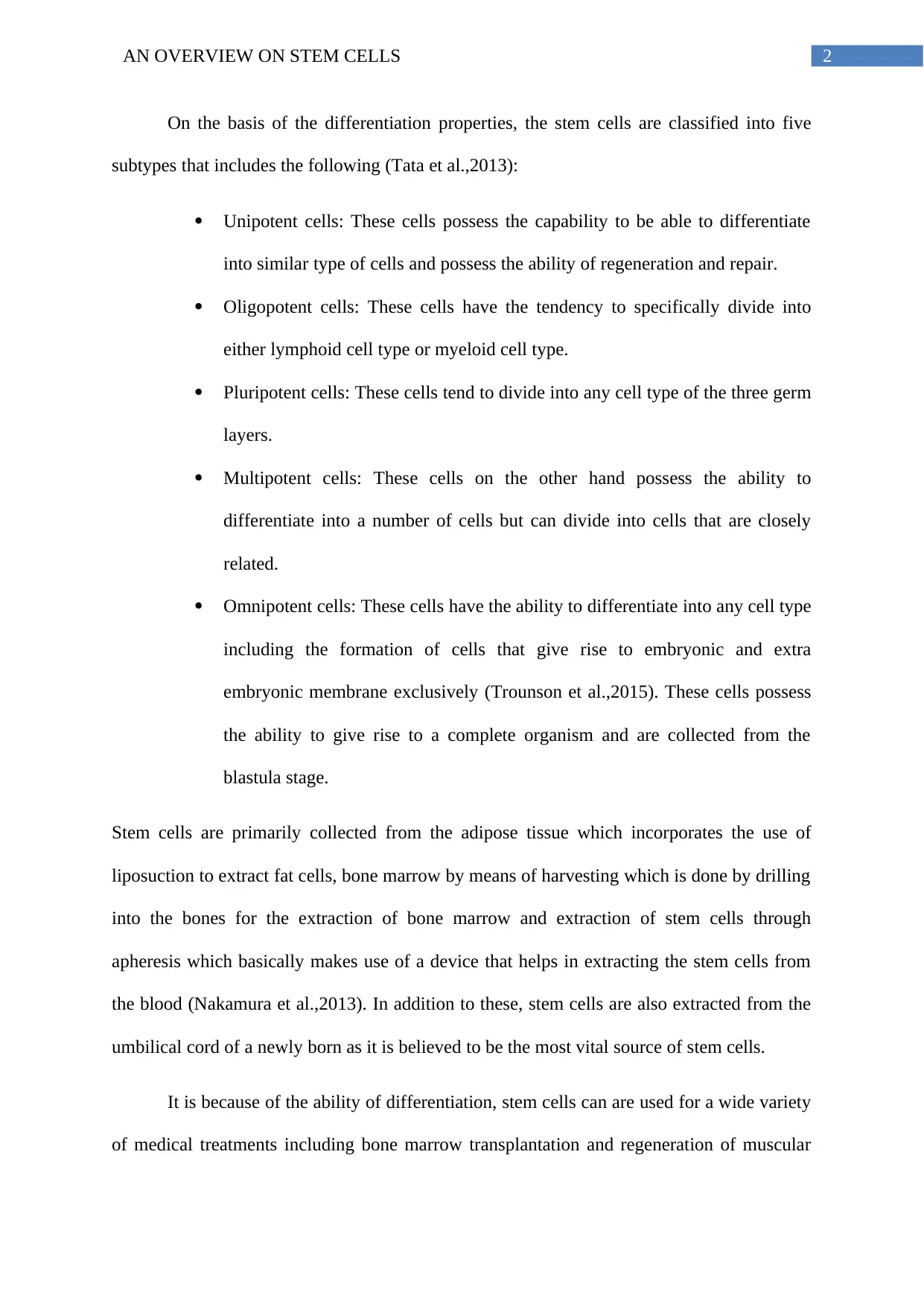
2AN OVERVIEW ON STEM CELLS
On the basis of the differentiation properties, the stem cells are classified into five
subtypes that includes the following (Tata et al.,2013):
Unipotent cells: These cells possess the capability to be able to differentiate
into similar type of cells and possess the ability of regeneration and repair.
Oligopotent cells: These cells have the tendency to specifically divide into
either lymphoid cell type or myeloid cell type.
Pluripotent cells: These cells tend to divide into any cell type of the three germ
layers.
Multipotent cells: These cells on the other hand possess the ability to
differentiate into a number of cells but can divide into cells that are closely
related.
Omnipotent cells: These cells have the ability to differentiate into any cell type
including the formation of cells that give rise to embryonic and extra
embryonic membrane exclusively (Trounson et al.,2015). These cells possess
the ability to give rise to a complete organism and are collected from the
blastula stage.
Stem cells are primarily collected from the adipose tissue which incorporates the use of
liposuction to extract fat cells, bone marrow by means of harvesting which is done by drilling
into the bones for the extraction of bone marrow and extraction of stem cells through
apheresis which basically makes use of a device that helps in extracting the stem cells from
the blood (Nakamura et al.,2013). In addition to these, stem cells are also extracted from the
umbilical cord of a newly born as it is believed to be the most vital source of stem cells.
It is because of the ability of differentiation, stem cells can are used for a wide variety
of medical treatments including bone marrow transplantation and regeneration of muscular
On the basis of the differentiation properties, the stem cells are classified into five
subtypes that includes the following (Tata et al.,2013):
Unipotent cells: These cells possess the capability to be able to differentiate
into similar type of cells and possess the ability of regeneration and repair.
Oligopotent cells: These cells have the tendency to specifically divide into
either lymphoid cell type or myeloid cell type.
Pluripotent cells: These cells tend to divide into any cell type of the three germ
layers.
Multipotent cells: These cells on the other hand possess the ability to
differentiate into a number of cells but can divide into cells that are closely
related.
Omnipotent cells: These cells have the ability to differentiate into any cell type
including the formation of cells that give rise to embryonic and extra
embryonic membrane exclusively (Trounson et al.,2015). These cells possess
the ability to give rise to a complete organism and are collected from the
blastula stage.
Stem cells are primarily collected from the adipose tissue which incorporates the use of
liposuction to extract fat cells, bone marrow by means of harvesting which is done by drilling
into the bones for the extraction of bone marrow and extraction of stem cells through
apheresis which basically makes use of a device that helps in extracting the stem cells from
the blood (Nakamura et al.,2013). In addition to these, stem cells are also extracted from the
umbilical cord of a newly born as it is believed to be the most vital source of stem cells.
It is because of the ability of differentiation, stem cells can are used for a wide variety
of medical treatments including bone marrow transplantation and regeneration of muscular
⊘ This is a preview!⊘
Do you want full access?
Subscribe today to unlock all pages.

Trusted by 1+ million students worldwide
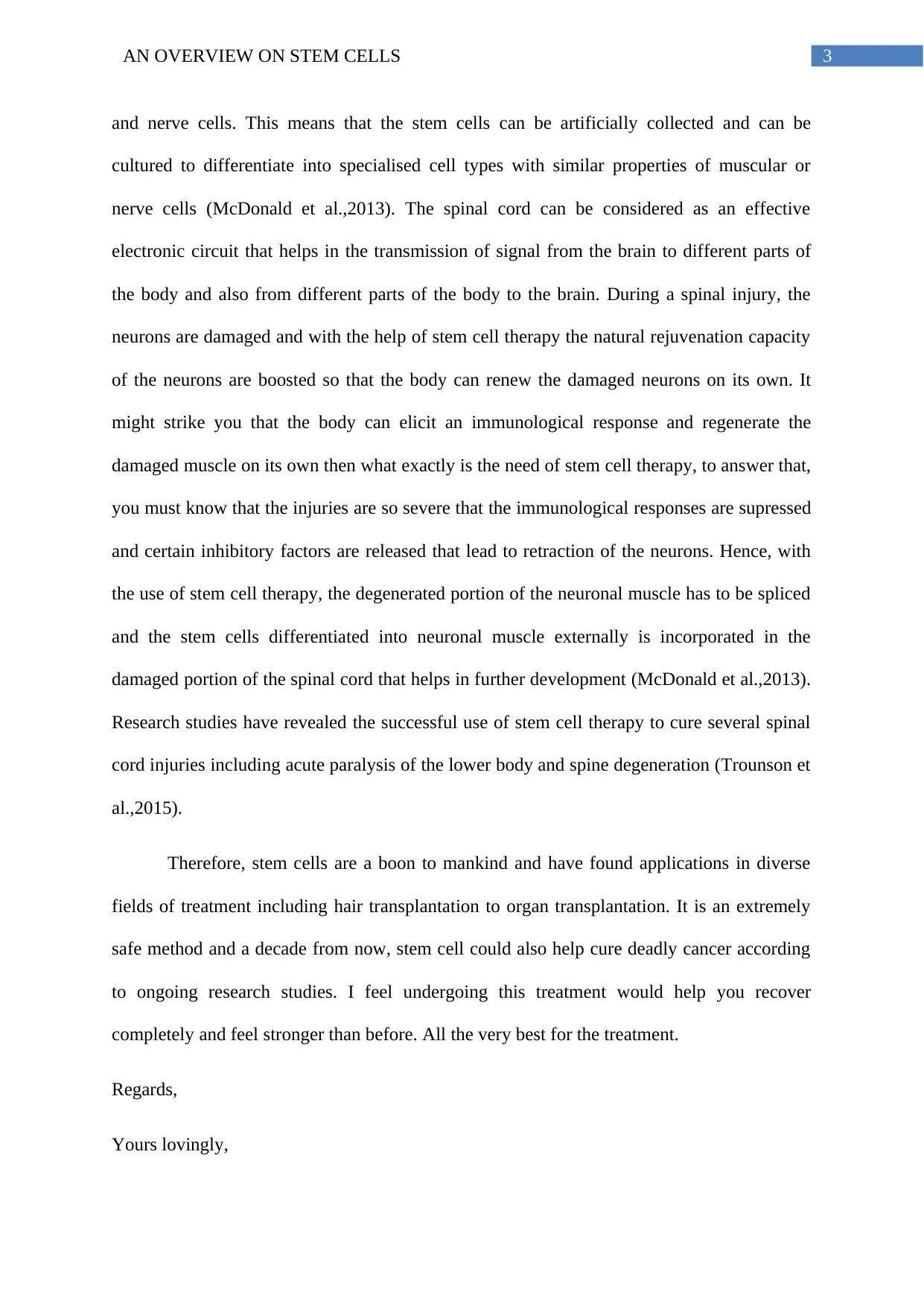
3AN OVERVIEW ON STEM CELLS
and nerve cells. This means that the stem cells can be artificially collected and can be
cultured to differentiate into specialised cell types with similar properties of muscular or
nerve cells (McDonald et al.,2013). The spinal cord can be considered as an effective
electronic circuit that helps in the transmission of signal from the brain to different parts of
the body and also from different parts of the body to the brain. During a spinal injury, the
neurons are damaged and with the help of stem cell therapy the natural rejuvenation capacity
of the neurons are boosted so that the body can renew the damaged neurons on its own. It
might strike you that the body can elicit an immunological response and regenerate the
damaged muscle on its own then what exactly is the need of stem cell therapy, to answer that,
you must know that the injuries are so severe that the immunological responses are supressed
and certain inhibitory factors are released that lead to retraction of the neurons. Hence, with
the use of stem cell therapy, the degenerated portion of the neuronal muscle has to be spliced
and the stem cells differentiated into neuronal muscle externally is incorporated in the
damaged portion of the spinal cord that helps in further development (McDonald et al.,2013).
Research studies have revealed the successful use of stem cell therapy to cure several spinal
cord injuries including acute paralysis of the lower body and spine degeneration (Trounson et
al.,2015).
Therefore, stem cells are a boon to mankind and have found applications in diverse
fields of treatment including hair transplantation to organ transplantation. It is an extremely
safe method and a decade from now, stem cell could also help cure deadly cancer according
to ongoing research studies. I feel undergoing this treatment would help you recover
completely and feel stronger than before. All the very best for the treatment.
Regards,
Yours lovingly,
and nerve cells. This means that the stem cells can be artificially collected and can be
cultured to differentiate into specialised cell types with similar properties of muscular or
nerve cells (McDonald et al.,2013). The spinal cord can be considered as an effective
electronic circuit that helps in the transmission of signal from the brain to different parts of
the body and also from different parts of the body to the brain. During a spinal injury, the
neurons are damaged and with the help of stem cell therapy the natural rejuvenation capacity
of the neurons are boosted so that the body can renew the damaged neurons on its own. It
might strike you that the body can elicit an immunological response and regenerate the
damaged muscle on its own then what exactly is the need of stem cell therapy, to answer that,
you must know that the injuries are so severe that the immunological responses are supressed
and certain inhibitory factors are released that lead to retraction of the neurons. Hence, with
the use of stem cell therapy, the degenerated portion of the neuronal muscle has to be spliced
and the stem cells differentiated into neuronal muscle externally is incorporated in the
damaged portion of the spinal cord that helps in further development (McDonald et al.,2013).
Research studies have revealed the successful use of stem cell therapy to cure several spinal
cord injuries including acute paralysis of the lower body and spine degeneration (Trounson et
al.,2015).
Therefore, stem cells are a boon to mankind and have found applications in diverse
fields of treatment including hair transplantation to organ transplantation. It is an extremely
safe method and a decade from now, stem cell could also help cure deadly cancer according
to ongoing research studies. I feel undergoing this treatment would help you recover
completely and feel stronger than before. All the very best for the treatment.
Regards,
Yours lovingly,
Paraphrase This Document
Need a fresh take? Get an instant paraphrase of this document with our AI Paraphraser
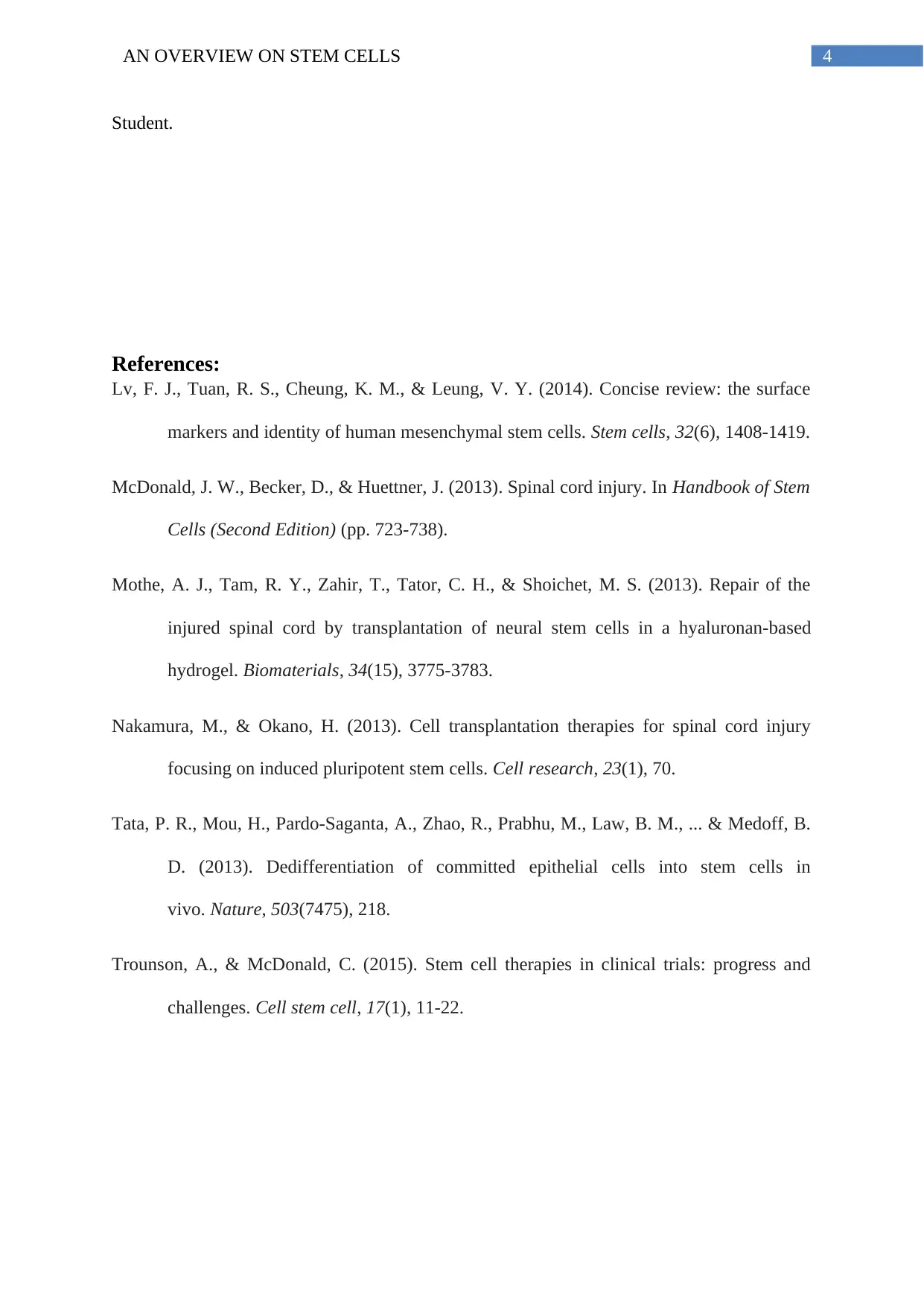
4AN OVERVIEW ON STEM CELLS
Student.
References:
Lv, F. J., Tuan, R. S., Cheung, K. M., & Leung, V. Y. (2014). Concise review: the surface
markers and identity of human mesenchymal stem cells. Stem cells, 32(6), 1408-1419.
McDonald, J. W., Becker, D., & Huettner, J. (2013). Spinal cord injury. In Handbook of Stem
Cells (Second Edition) (pp. 723-738).
Mothe, A. J., Tam, R. Y., Zahir, T., Tator, C. H., & Shoichet, M. S. (2013). Repair of the
injured spinal cord by transplantation of neural stem cells in a hyaluronan-based
hydrogel. Biomaterials, 34(15), 3775-3783.
Nakamura, M., & Okano, H. (2013). Cell transplantation therapies for spinal cord injury
focusing on induced pluripotent stem cells. Cell research, 23(1), 70.
Tata, P. R., Mou, H., Pardo-Saganta, A., Zhao, R., Prabhu, M., Law, B. M., ... & Medoff, B.
D. (2013). Dedifferentiation of committed epithelial cells into stem cells in
vivo. Nature, 503(7475), 218.
Trounson, A., & McDonald, C. (2015). Stem cell therapies in clinical trials: progress and
challenges. Cell stem cell, 17(1), 11-22.
Student.
References:
Lv, F. J., Tuan, R. S., Cheung, K. M., & Leung, V. Y. (2014). Concise review: the surface
markers and identity of human mesenchymal stem cells. Stem cells, 32(6), 1408-1419.
McDonald, J. W., Becker, D., & Huettner, J. (2013). Spinal cord injury. In Handbook of Stem
Cells (Second Edition) (pp. 723-738).
Mothe, A. J., Tam, R. Y., Zahir, T., Tator, C. H., & Shoichet, M. S. (2013). Repair of the
injured spinal cord by transplantation of neural stem cells in a hyaluronan-based
hydrogel. Biomaterials, 34(15), 3775-3783.
Nakamura, M., & Okano, H. (2013). Cell transplantation therapies for spinal cord injury
focusing on induced pluripotent stem cells. Cell research, 23(1), 70.
Tata, P. R., Mou, H., Pardo-Saganta, A., Zhao, R., Prabhu, M., Law, B. M., ... & Medoff, B.
D. (2013). Dedifferentiation of committed epithelial cells into stem cells in
vivo. Nature, 503(7475), 218.
Trounson, A., & McDonald, C. (2015). Stem cell therapies in clinical trials: progress and
challenges. Cell stem cell, 17(1), 11-22.
1 out of 5
Your All-in-One AI-Powered Toolkit for Academic Success.
+13062052269
info@desklib.com
Available 24*7 on WhatsApp / Email
![[object Object]](/_next/static/media/star-bottom.7253800d.svg)
Unlock your academic potential
Copyright © 2020–2025 A2Z Services. All Rights Reserved. Developed and managed by ZUCOL.


